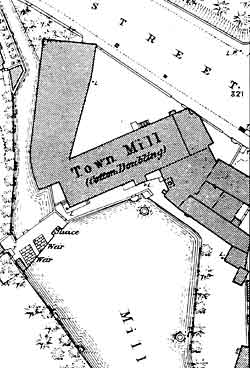
 |
Detail of Ordnance Survey 10ft-to-one-mile map of Mansfield (1877), showing the Town Mill on the River Maun. |
Cartographic
Printed
The general location of some major industrial buildings and sites are to be found on the early medium-scale maps by Chapman (1774); Sanderson (1835) showing twenty miles around Mansfield and indicates sites such as windmills, bleaching works and brick kilns and the Ordnance Survey (1840s onwards) 1” series (Nottinghamshire Archives)
Detailed block-plan depictions of all buildings can be found in the large-scale Ordnance survey maps published from the 1880s. There is uniform coverage of the county at 1:2500 from the 1880s (1:1250 from the 1950s) and at 1:500 for Nottingham in the 1880s (Nottinghamshire Archives and Nottinghamshire Local Studies Library).
From the late 19th century until the 1970s the Goad company produced detailed plans for assessing fire insurance risks and these provide important detail of the location and nature of internal walls, roofs and other features not detailed on OS plans. There are Goad plans for the central area of Nottingham (copies in Nottingham Local Studies Library [NLSL], Nottingham Central Library, Angel Row, Nottingham, and the British Library Map Room).
In the nineteenth and early twentieth centuries properties for sale by auction frequently had detailed plans created for the published sale catalogue. Many such catalogues have survived and are listed in Nottinghamshire Archives.
Manuscript
Building control plans provide the most important source for depictions in manuscript of the layout of industrial buildings. These frequently include coloured elevations of the building as well. Note that these documents represent what was intended and not what was built. Often there were alterations made before approval was granted. Building control began in Nottingham in 1870s and in other urban areas in the 1880s. Often the plans are very fragile and in some authorities have been either destroyed outright or survive only on microfilm. Nottinghamshire Archives can provide details.